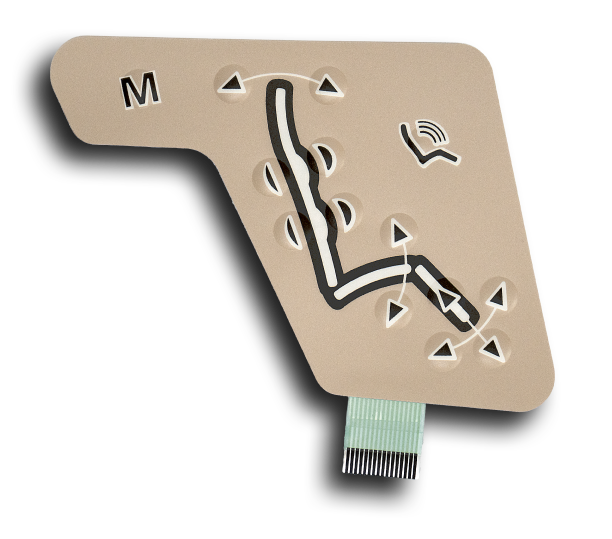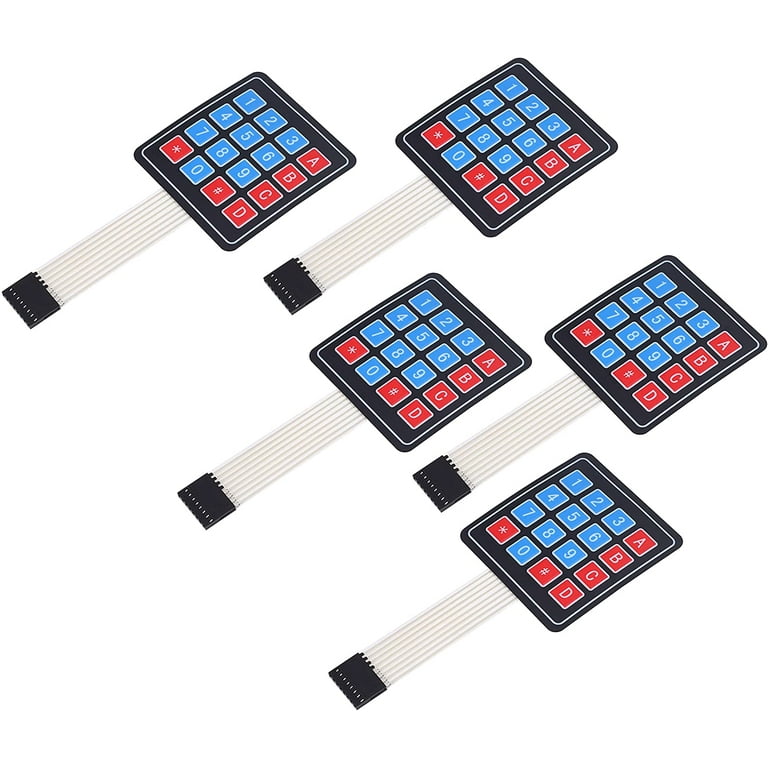Industry-Leading Membrane Switch Manufacturer with International Standards
Industry-Leading Membrane Switch Manufacturer with International Standards
Blog Article
Checking Out the Manufacturing Process of Membrane Switch for Various Industries
The manufacturing procedure of Membrane buttons is a complex undertaking that requires precision and focus to information. From selecting appropriate products to carrying out rigorous high quality control steps, each step plays an essential duty in ensuring performance. Various industries, consisting of clinical and automotive, rely on these parts for their special applications. Understanding the complexities of this procedure discloses considerable understandings right into just how these switches are created and their impact across diverse industries.
Recognizing Membrane Switches: A Summary

Key Materials Utilized in Membrane Switch Manufacturing
In Membrane button manufacturing, the choice of essential materials significantly affects functionality and longevity. Conductive materials, adhesives, and coatings play vital duties, while substrate option influences general performance and dependability. Understanding these parts is vital for maximizing the style and production of Membrane buttons.
Conductive Products Summary
Conductive products play an important role in the capability of Membrane buttons, making sure trusted electric connections within the gadget. Frequently utilized products include silver, copper, and carbon-based inks, each offering distinctive advantages. Silver is favored for its high conductivity and toughness, making it optimal for applications needing robust efficiency. Copper, while a little less conductive than silver, is an economical option frequently made use of in printed circuits. Carbon-based inks give a functional option, suitable for applications where flexibility and reduced costs are prioritized, although they have lower conductivity contrasted to steel alternatives. The option of conductive materials straight influences the overall dependability, lifespan, and performance of the Membrane button, making it a crucial consideration in the manufacturing process.
Adhesives and Coatings
Coverings and adhesives are crucial components in the production of Membrane buttons, offering crucial bonding and protective residential or commercial properties. These products ensure that different layers of the switch, including graphic overlays and circuitry, stick safely to each other, boosting sturdiness and capability. Generally used adhesives consist of pressure-sensitive adhesives (PSAs) and epoxy-based solutions, which offer solid attachment and resilience. Coatings, such as polyurethane or acrylic, offer to shield versus environmental elements, including moisture, abrasion, and chemicals. Additionally, coverings can boost responsive responses and aesthetic appeal, adding to the general customer experience. The choice of suitable adhesives and coverings is vital for enhancing performance and durability in diverse applications across numerous markets, making certain that Membrane changes meet details operational needs.
Substrate Selection Factors
Substrate option plays a crucial function in the manufacturing of Membrane buttons, as it significantly affects their general performance and toughness. Secret materials such as polyester, polycarbonate, and flexible printed circuit boards (FPCBs) are frequently used for their distinctive residential properties. Polyester is preferred for its cost-effectiveness and resistance to abrasion, making it appropriate for applications with high wear. Polycarbonate deals remarkable clarity and impact resistance, ideal for settings calling for high exposure. FPCBs supply enhanced flexibility and are frequently utilized in complicated designs. The selection of substrate likewise influences variables like thermal stability, chemical resistance, and convenience of printing. Ultimately, choosing the suitable substratum is vital for ensuring the performance and longevity of Membrane switches over throughout numerous industries.
The Style Refine of Membrane Changes
The design procedure of Membrane buttons is a vital phase that considerably affects the functionality and appearances of the final product - membrane switch manufacturer. It begins with specifying the certain needs of the application, consisting of dimensions, button layout, and tactile responses preferences. Designers must think about user communication, making sure that the button is intuitive and accessible.Next, materials are chosen based on sturdiness, flexibility, and environmental resistance. The combination of graphics and branding elements is also crucial, as it enhances aesthetic allure and interaction. Prototyping permits repetitive screening, making it possible for adjustments based on user responses and performance evaluations.Additionally, the style should account for the electrical elements, such as ports and circuits, guaranteeing dependability and convenience of use. Ultimately, a successful design harmonizes capability, aesthetic appeals, and user experience, leading the way for efficient production and lasting performance in numerous sectors
Printing Methods for Membrane Switches
The printing techniques utilized in Membrane switch production play an over at this website essential duty in figuring out the final product's high quality and functionality. Display printing provides advantages such as sturdiness and vibrant shade application, while electronic printing developments visit provide versatility and precision in style. Recognizing these techniques can greatly impact the overall performance of Membrane switches in different applications.
Display Printing Advantages
Many benefits make display publishing a favored strategy for generating Membrane buttons. This technique enables top quality, comprehensive styles and vivid shades, which are important for individual interface applications. Screen printing is specifically effective for using thick ink layers, improving toughness and tactile feedback. Additionally, it supplies superb adhesion to numerous substratums, making certain durability sought after atmospheres. The procedure is affordable for big production runs, as it minimizes configuration time and waste. Moreover, display printing supports a variety of inks, including specialized and UV-curable choices, allowing adaptability in style. Its capability to generate constant outcomes across numerous units makes it a trusted selection for makers going for high quality and effectiveness in Membrane button production.
Digital Printing Innovations

Innovations in digital printing technology are transforming the manufacturing of Membrane switches, providing suppliers ingenious services that improve layout adaptability and efficiency. Digital printing permits complex layouts and high-resolution graphics, allowing custom branding and functionality without the constraints of standard approaches. This strategy reduces arrangement times and expenses, assisting in much shorter production runs and marginal waste, making it suitable for organizations with varying needs. Additionally, developments in ink formulas offer much better toughness and bond, making sure durability in different atmospheres. As industries increasingly look for intricate and personalized layouts, digital printing sticks out as a necessary strategy, establishing a brand-new requirement in Membrane switch manufacturing. The integration of these technologies settings suppliers to fulfill advancing market needs efficiently.
Assembly and Layering of Membrane Switch Components
Mindful setting up and layering of Membrane switch parts are important to guaranteeing capability and toughness. This process starts with the accurate alignment of numerous layers, including the visuals overlay, glue, circuit layer, and backing product. Each element has to be very carefully positioned to keep electrical stability and customer interface responsiveness.During assembly, conductive traces are used to the circuit layer, usually made from products like polyester or polycarbonate. This layer is essential, as it beams when stress is applied. The sticky made use of for bonding these layers is likewise picked for its ability to withstand ecological anxieties while preserving a secure bond.Heat and stress are commonly applied throughout the setting up procedure to determine that the layers adhere effectively without endangering the functionality of the switch. Interest is offered to the side sealing to protect versus moisture and impurities, securing the long life of the Membrane button in various industrial applications.
Quality Assurance Procedures in Membrane Switch Manufacturing
Quality control steps play a crucial role in guaranteeing the dependability and efficiency of Membrane changes following the assembly and layering of their components. In the production procedure, numerous vital inspections are conducted to promote top quality criteria. These consist of visual evaluations for problems in printing and adhesive application, as well as functional examinations to confirm the responsiveness of each switch.Additionally, ecological screening is carried out to evaluate the buttons' toughness against temperature level changes and moisture exposure. Manufacturers usually apply analytical process control (copyright) methods to check manufacturing consistency, making it possible for very early detection of anomalies.Furthermore, traceability systems are established to track products and parts, making certain liability and promoting remembers if necessary. Calibration of tools and adherence to industry standards are also crucial go to these guys to preserving product honesty. Jointly, these quality control procedures secure the efficiency of Membrane switches across numerous applications, eventually enhancing customer contentment.
Applications of Membrane Changes Across Different Industries
Membrane buttons are utilized across a diverse variety of sectors, showcasing their adaptability and flexibility. In the medical field, they provide water-proof and dependable user interfaces for tools such as analysis devices and mixture pumps, making certain hygiene and convenience of usage. The auto industry employs Membrane buttons for control panel controls, making it possible for smooth interaction in between the motorist and lorry systems.In customer electronic devices, these buttons are found in home appliances and portable tools, supplying a streamlined, contemporary visual while boosting capability. Industrial applications also take advantage of Membrane switches for equipment control board, where sturdiness and resistance to extreme problems are essential.Furthermore, the aerospace and protection sectors utilize Membrane buttons for cabin instrumentation and communication systems, prioritizing reliability and performance under extreme problems. On the whole, Membrane switches play a crucial function in enhancing the user experience and functional efficiency across various domain names.
Regularly Asked Questions
For how long Does It Require To Make a Membrane Layer Switch?
The manufacturing time for a membrane layer button generally ranges from a few days to numerous weeks - membrane switch manufacturer. Aspects affecting this period include layout intricacy, material schedule, and production quantity, all influencing the total timeline noticeably
What Is the Common Lifespan of a Membrane Layer Switch?
The typical life-span of a membrane switch generally varies from 1 to 5 million actuations, depending on variables such as worldly high quality, environmental problems, and usage regularity, substantially affecting durability and total performance.
Can Membrane Changes Be Custom-made for Particular Applications?
Membrane switches can indeed be personalized for specific applications. Their style flexibility enables alterations in dimension, form, shades, and graphics, ensuring compatibility with special needs across various sectors and improving capability and user experience.

Are Membrane Switches Over Eco-friendly?
The environmental effect of Membrane switches over differs. Some materials utilized might not be eco-friendly, while improvements in manufacturing processes are progressively concentrating on sustainability, aiming to decrease waste and advertise recyclable parts in their production.
What Are the Typical Failing Settings of Membrane Switches?
Common failure modes of Membrane buttons consist of delamination, adhesive failure, wear and tear from use, dampness access, and electric failures. These concerns can considerably influence capability, performance, and life-span in different applications across different markets. Membrane switches can be personalized to fit certain layout needs, such as performance, dimension, and shape, making them highly adaptable.The construction normally entails several layers, including a visuals overlay, adhesive, and a circuit layer, which function with each other to develop a smooth user experience. In Membrane switch manufacturing, the choice of vital materials significantly influences functionality and resilience. The auto sector employs Membrane switches for dashboard controls, enabling smooth communication between the driver and lorry systems.In customer electronics, these switches are discovered in appliances and handheld tools, providing a sleek, modern-day visual while improving performance. Industrial applications additionally take advantage of Membrane changes for machinery control panels, where longevity and resistance to severe problems are essential.Furthermore, the aerospace and protection fields use Membrane buttons for cabin instrumentation and communication systems, focusing on reliability and performance under severe problems. Membrane switches can indeed be tailored for details applications.
Report this page